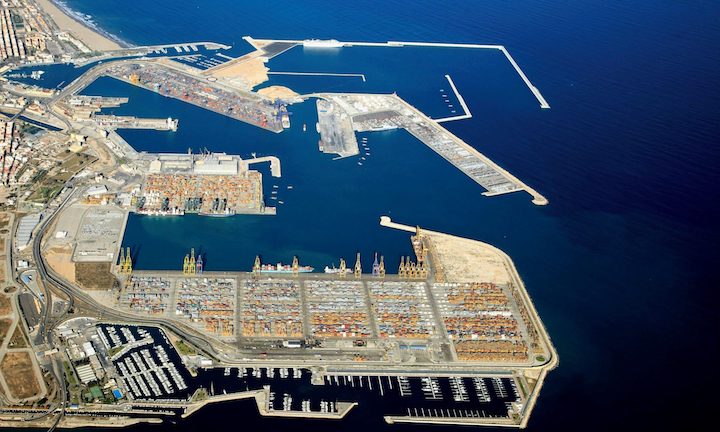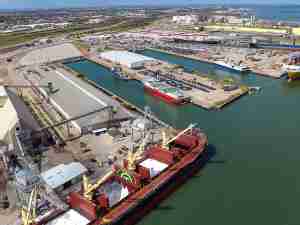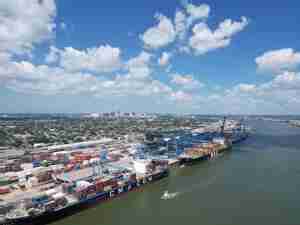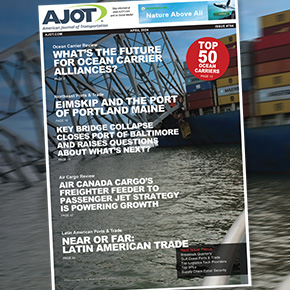The European Union has supported the works inside the northern extension of the Port Authority of Valencia (PAV) where the new northern container terminal will be located. The European Parliament's Committee on Petitions has responded that this infrastructure complies with the European Union's environmental legislation. Specifically, the report by this European institution states that "the Commission has not been able to identify any indication of possible infringement of EU environmental legislation" and continues that "the Commission considers that the relevant review procedures provided for by the Spanish legal system under the EIA Directive and/or Directive 2003/4/EC would be the most effective mechanism to seek redress and satisfactorily deal with any possible cases of misapplication of EU law". The resolution of the European body concludes that it "cannot follow up this case any further", thus responding to an allegation made by a citizen about this infrastructure.

The response of this institution is added to the recent acknowledgements by Puertos del Estado and the Ministry for Ecological Transition and the Demographic Challenge of the adjustment to the legality and rigour of the works and projects in terms of infrastructures and the new north terminal of the Port Authority of Valencia (PAV).
In this regard, it is worth noting the report by Puertos del Estado, which states that the project for the New North Terminal of the Port of Valencia does not require a new Environmental Impact Statement (EIS). The legal report issued by this body states that the project has a favourable EIS and that "the works began to be carried out within a year of its publication, so it is considered that the EIS is in force, as it does not fall under any of the expiry conditions of the legislation on environmental assessment, including the current Law 21/2013, of 9 December, on environmental assessment".
Furthermore, it should be remembered that the Ministry for Ecological Transition and the Demographic Challenge has determined the PAV's status as the substantive body in the performance of this infrastructure. The PAV wishes to highlight the support of different national and European institutions for this revitalising project that combines economic growth with sustainability, and recalls that it will meticulously and scrupulously comply with each and every one of the observations made by Puertos del Estado and the indicators contemplated in the EIS.
A benchmark in environmental sustainability and employment
The container terminal planned for the inland waters of the northern extension of the Port of València is a clear example of an infrastructure that combines sustainability and growth. On the one hand, the new terminal will be the most environmentally advanced in the world, and on the other hand, it will contribute to generating employment and wealth in the Valencian Community and Spain. Thus, in environmental terms, this infrastructure will be a smoke-free space, as it will minimise CO2 emissions by supplying electricity to cranes and yard machinery, and to container ships. The project presented by TIL/MSC to Valenciaport includes the electrification of 98% of the driving components and installations of the terminal; and in addition, 100% of the electricity will come from renewable sources, which in turn will imply a 98% reduction in CO2 emissions. In its project, TIL makes an important commitment to intermodality and offers to develop a railway terminal equipped with six 1,000-metre-long tracks, with the capacity to move 305,000 TEUs/year by rail. Moreover, the automation of certain processes of the infrastructure will mean the creation of a technological cluster around it with the consequent creation of highly qualified employment.
Specifically, with the new terminal in operation, the economic impact of the Port of Valencia will represent in terms of added value 2.27% of the whole of the Comunitat, with more than 44,000 qualified and quality jobs, whose average salary will be around 32,000 euros per year, according to the study carried out by the Institute of Transport and Territory (ITRAT) for this project. The new port infrastructure will create more than 17,000 new jobs in the period 2022-2023 and around 15,000 between 2024-2026. In 2023 alone, directly, it will offer around 18,500 jobs in addition to those of the port community, a figure which will be higher in 2025, when it will reach 19,800. Similarly, indirectly, more than 4,200 new jobs will be created in 2023 and 2025.
Conclusions in terms of employment
1. The new Port infrastructure will allow the creation of a total of 17,017 new jobs in the period 2022-2023 and 15,284 jobs between 2024-2026.
2. Every euro invested in the equipment of the new northern terminal will generate a total effect of 1.56 euros in the productive sectors of the Valencian economy.
3. On a social level, the impact will be very significant: directly, in 2023, the Port of Valencia will generate 18,461 jobs in addition to those of the port community itself, a figure which will be higher (19,800) in 2025.
4. In indirect terms, the employment created will also be important: in the two years of analysis, more than 4,200 workers will be employed in 2023 and 2025.
5. The induced effect, which is less than the direct effect, will reach figures of around 13,000 jobs in each year analysed. These jobs can be considered stable and lasting over time.
6. During these years, there will be an overlap of activity: on the one hand, the development of the terminal and, on the other hand, the activity resulting from port traffic. Thus, if investments are made in a linear fashion and economies of scale are not exploited, the employment generated in 2023 could reach 44,000 jobs and in 2025 it would be close to 43,000 jobs.
7. The economic impact of the investments for the equipment of the new northern terminal will mean a change in final demand in the construction sector. The planned investment of almost €1.5 billion will have a direct effect of more than €1.2 billion on the productive fabric (628.5 between 2022-2023 and 586.2 between 2024-2026).
8. At an aggregate level, the results of the direct effect show a notable increase in the volume of wages and salaries and in business profits, 214.3 and 281.5 M€ respectively in the period 2022-2023, and 199.9 and 262.5 M€, respectively, for the period 2024-2026.
9. The economic aggregates of the indirect effect reveal that wages have a significant weight in gross value added. The volume of the induced effect (388 M € in gross value added in 2022-2023) is higher than that of the indirect effect (155 M € in GVA in 2022-2023), but without reaching the levels of the direct effect (519 M € in GVA in 2022-2023).
10. Furthermore, the gross value added of the Valencian economy will experience an increase of more than €2,000 M in 2022-2026, with a generation of tax revenues of around €85.79 M.
11. The total economic impact of the port of Valencia when the terminal is partially active has been calculated using official traffic forecasts. This has made it possible to estimate that in 2023 the port's activity will exceed €1.6 billion and in 2025 it could exceed €1.8 billion. The results reveal that directly, the port of Valencia will generate an increase in gross added value of 1,186 and 1,321 M€ in 2023 and 2025 respectively, where salaries will have the greatest weight, an issue which is repeated in the indirect and induced effect. The sum of all of them adds up to a total effect of 1,021 and 1,138 M€ in terms of wages, while gross profits will reach 966 and 1,076 during the years 2023 and 2025. The increase in total gross value added will represent around 1.9% of the gross value added of the Valencian Community.










